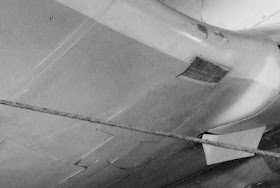Saturday, October 13, 2012
Friday, October 12, 2012
F4U Main Landing Gear Door Attachment
One incorrect assumption that plastic kit manufacturers make about the shape of the forward-facing main landing gear door on the F4U Corsair is that the opening is the same shape as the door or vice versa. The problem is that the opening between the top of the door and the front of the opening was closed by a piece of leather or rubber; the opening extends farther forward toward the wing leading edge than the door itself covers. Here you can see the flexible gap-filler material doubled over on a restored Corsair.
And here it is with the gear up on the XF4U:
And here it is with the gear up on the XF4U:
Saturday, October 6, 2012
F-4 Phantom Forward Fuselage
Mark Nankivil provided me with a McDonnell lines drawing of the F-4B/J Phantom. Questions have been raised about the shape of the Academy 1/48 F-4 nose. For what it's worth, here is the forward fuselage with a reference box for scale.
One interesting feature is that the break between the radome and the fuselage is not perpendicular to the line of symmetry of the ogival radome, which is what you'd expect.
The IR sensor fairing side view and cross section:
One interesting feature is that the break between the radome and the fuselage is not perpendicular to the line of symmetry of the ogival radome, which is what you'd expect.
The IR sensor fairing side view and cross section:
Thursday, October 4, 2012
Douglas DT-2
Yet another draft based on an IPMS Tailhook Topics column.
The Douglas DT-2 was one of the U.S. Navy's first torpedo bombers. It was operated as both a seaplane and from Langley as shown here.
It was based on the Douglas World Cruiser, which the Army flew around the world in 1924. The major external changes were:
- Cut-down upper aft fuselage
- Rear cockpit moved aft
- Front cockpit opening larger and squared off
- New nose, vertical fin and rudder
- Recess in the bottom of the fuselage for mounting the torpedo
- No dihedral in the upper wing or center section cutout (there was also a fairing on the right hand inboard upper surface)
- Added cutout in the lower inboard wing to allow access to the cockpit when the floats were installed
- The horizontal tail was moved forward and enlarged accordingly
- Tailhook
- Initially, a propeller guard and hooks on the landing gear spreader bars to engage the longitudinal wires on the early arresting system
This is a pretty good drawing that I did back then from Douglas drawings provided to me by Harry Gann. Unfortunately, the tailhook is speculative. (Click on it for a larger and downloadable view.)
The torpedo was probably the Mk 7, which was 17 feet long and 18 inches in diameter:
The Douglas DT-2 was one of the U.S. Navy's first torpedo bombers. It was operated as both a seaplane and from Langley as shown here.
It was based on the Douglas World Cruiser, which the Army flew around the world in 1924. The major external changes were:
- Cut-down upper aft fuselage
- Rear cockpit moved aft
- Front cockpit opening larger and squared off
- New nose, vertical fin and rudder
- Recess in the bottom of the fuselage for mounting the torpedo
- No dihedral in the upper wing or center section cutout (there was also a fairing on the right hand inboard upper surface)
- Added cutout in the lower inboard wing to allow access to the cockpit when the floats were installed
- The horizontal tail was moved forward and enlarged accordingly
- Tailhook
- Initially, a propeller guard and hooks on the landing gear spreader bars to engage the longitudinal wires on the early arresting system
This is a pretty good drawing that I did back then from Douglas drawings provided to me by Harry Gann. Unfortunately, the tailhook is speculative. (Click on it for a larger and downloadable view.)
The torpedo was probably the Mk 7, which was 17 feet long and 18 inches in diameter:
Wednesday, October 3, 2012
F9F-2KD Regulus Controller Trainer
A Work In Progress
This airplane was used to train Regulus missile controllers. It was not a true drone since a pilot was required for takeoff and landing.
This airplane was used to train Regulus missile controllers. It was not a true drone since a pilot was required for takeoff and landing.
National Archives 80-GK- 23622
National Archives 80-GK-23623
Assigned to GMGRU-1. Pictures reportedly taken 29 June 1958 at Point Mugu.








